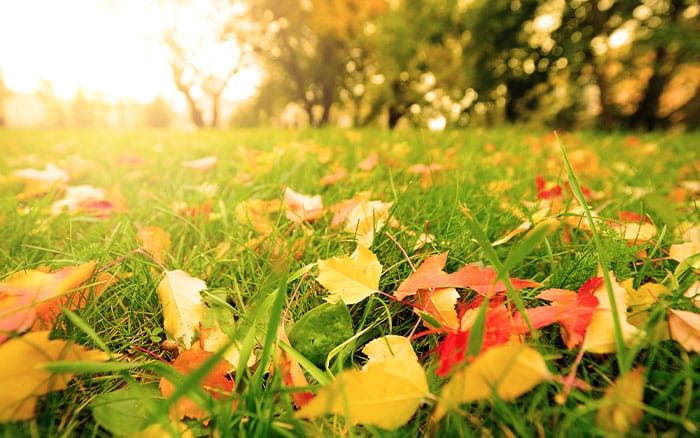Russet hues and earthy tones are taking over again, with the crunch – or squelch – of leaves underfoot. You can bring glorious autumn colour to your garden with fiery reds, yellows and oranges. Here’s how…
Turn a new leaf
So why do leaves turn orange and why do they fall? As the days get shorter, the length of daylight and temperature the plant has access to changes, so the leaves stop their process of making food.
The orange and yellow pigments become more visible because the chlorophyll breaks down, so the green colour disappears.

Deciduous plants shed the part of the plant that they no longer need to survive autumn and winter.
Trees and shrubs drop their leaves because the vessels that carry the water and nutrients to the rest of the plant are closed off and a new layer forms that separates the leaf from the tree, which means it falls. Hence the autumn term “fall”.
Autumnal tones

You don’t need a Japanese-style garden to have a Japanese maple. In fact, they are perfect for any size space and can be grown in containers too. They will grace your garden or outdoor area with their lobed leaves that have green, orange, red and even purple tones, putting on a spectacular show through the year.
Acer palmatums like to grow in a slightly shaded spot with fertile soil.
‘Katsura’ is a hardy pick that begins with pink and orange leaves in spring, and goes green in summer, followed by orange in autumn.
For more dramatic colour, ‘Dissectum’ will provide fiery tones of red, orange and yellow. A sheltered and partially shaded spot will serve up the best autumn colour from this.
Berries and cherries
This time of year is best to plant fruit trees and bushes such as redcurrants, gooseberries and raspberries. But among my favourites are blueberries, which need to be planted in a sheltered position with acidic soil.
However, if you don’t have acidic soil, they can be grown in containers using Miracle-Gro Premium azalea, camellia and rhododendron ericaceous compost.

Either plant them separately or mix in borders as they make nice ornamental plants as well as producing delicious berries. They provide flowers in spring,
fruit in summer and lovely foliage in autumn.
Another tree for the garden for autumn colour is Prunus ‘Accolade’, ornamental cherry, which can grow up to 8m tall. This hardy tree has orange and red autumn foliage and, in spring, stunning light pink flowers bloom.
Prunus serrula (Tibetan cherry) is a round-headed tree that has amazing copper-coloured and textured bark, and white flowers in spring. In autumn, the narrow leaves are yellow, so this tree will without doubt bring interest to your garden.
What’s in a name?

One of my favourite plant names is Liquidambar styraciflua (sweet gum), which is a tree that is slightly conical in shape and is adorned with maple-like leaves that are orange, scarlet red and purple in autumn.
They aren’t fussy with the position they are grown in as long as there is sufficient sun and lime-free soil.
Another interestingly named plant is Cotinus, known as the smoke tree. It is a large shrub that has green leaves in spring and summer that become a gorgeous red and gold through autumn.
Not only is their foliage appealing, but in summer, pink and feathery inflorescences bloom that add even more texture. This makes them a great addition to an architectural garden.
Creeping colour
It is not just shrubs and trees that can provide autumnal tones though. Boston ivy is a great pick to adorn your home or fences, and it will give the best autumnal colour if positioned in partial or full shade.
This large climber has three-lobed leaves that are green throughout the spring and summer but, come autumn, they turn crimson and purple.

Also, blue berries fruit in autumn – these are harmful to humans and pets, but wild birds will enjoy them. Late Dutch honeysuckle ‘Serotina’ is another hardy climber with plenty to offer. The fragrant, red-purple flowers show off during summer and are followed in autumn by red berries.
Not only can you enjoy the fascinating flowers, but pollinators love them too, so they’re sure to go down well in your garden.
Grow in full sun or partial shade in any moist, well-drained soil type for it to thrive.
Tip:
Plant bulbs using the lightbulb technique – gently twist and push down into the soil to avoid leaving pockets for water to collect in, which rots them.
So add warm, fiery autumn colour to your garden with these plants that have flowers, foliage and fruit.
Happy gardening everyone!
Reader questions
I’ve had a huge harvest of apples this year and don’t know what to do with them.

You can store them by wrapping the apples in newspaper and keeping them on an airy tray in a shed or garage. Check regularly to remove any that are rotting. Or juice them, freeze them for use in smoothies or baking, or mush to make a compote.
Can I protect my outdoor plants from frost?

To ensure the topsoil around plants doesn’t freeze, apply an inch or two of garden mulch or woodchip. Also, cover vulnerable plants, such as palms, overnight with an old blanket or horticultural fleece. With vulnerable container varieties, such as dahlias, bring them indoors.

Leave A Comment